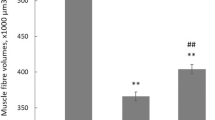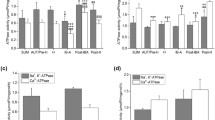Abstract
The changes in the content of the giant sarcomeric cytoskeletal proteins titin (3000–3700 kDa) and nebulin (770 kDa) in skeletal muscles (m. soleus, m. gastrocnemius), and titin in the left ventricular myocardium, as well as of the submembrane cytoskeletal protein dystrophin (427 kDa) in m. soleus and m. extensor digitorum longus (EDL), have been studied in the edible dormouse Glis glis during hibernation. The animals were divided into two experimental groups: “Summer activity” and “Hypothermia”. It was found that the development of atrophic changes in the skeletal muscles of hibernating animals is accompanied by a decrease in the dystrophin content. Specifically, the fluorescence intensity in skeletal muscle cross sections labeled with primary antibodies to dystrophin and Alexa Fluor® 488 conjugated secondary antibodies decreased in animals of the “Hypothermia” group by 2.7 times (p < 0.05) and 2.0 times (p < 0.05) in m. soleus and m. EDL, respectively. SDS electrophoresis of proteins in agarose-strengthened macroporous 2.2%-polyacrylamide gel revealed an insignificant decrease (by 15%, p ≤ 0.01) in the titin content compared to the myosin heavy chain content in m. gastrocnemius of animals of the “Hypothermia” group. The titin content in m. soleus and cardiac muscle, as well as the nebulin content in m. soleus and m. gastrocnemius, did not decrease during hibernation. These results are consistent with our previous data for other hibernators: long-tailed ground squirrel, brown and Himalayan black bears. It can be assumed that during evolution, hibernating animals developed the molecular mechanisms responsible for maintaining a stable level of giant sarcomeric cytoskeletal proteins during hibernation.





Similar content being viewed by others
Abbreviations
- Т1:
-
intact titin, a full-length molecules that span the distance from the M-line to Z-disk in a sarcomere of the vertebrate striated muscle
- Т2:
-
proteolytic titin fragments oriented along myosin filaments in the sarcomeric M-line region and A-band
- MHC:
-
myosin heavy chains that form a myosin filament
- CSA:
-
cross-sectional area
- m. EDL :
-
musculus extensor digitorum longus
REFERENCES
Ruf T, Bieber C (2020) Physiological, behavioral, and life-history adaptations to environmental fluctuations in the edible dormouse. Front Physiol 11: 423. https://doi.org/10.3389/fphys.2020.00423
Vogel P (1997) Hibernation of recently captured Muscardinus, Eliomys and Myoxus: a comparative study. Nat Croat 6(2): 217–231.
Wiltz M, Heldmaier G (2000) Comparison of hibernation, estivation and daily torpor in the edible dormouse, Glis glis. J Compar Physiol B 170: 511–521. https://doi.org/10.1007/s003600000129
French AR (1982) Effects of temperature on the duration of arousal episodes during hibernation. J Appl Physiol Respir Environ Exerc Physiol 52(1): 216–220. https://doi.org/10.1152/jappl.1982.52.1.216
Bieber C, Lebl K, Stalder G, Geiser F, Ruf T (2014) Body mass dependent use of hibernation: why not prolong the active season, if they can? Funct Ecol 28: 167–177. https://doi.org/10.1111/1365-2435.12173
Anufriev AI, Okhlopkov IM (2015) Hibernation of three species of the Sciuridae family in Yakutia with a body temperature below zero. Russ J Ecol 46(2): 167–174. (In Russ). https://doi.org/10.1134/S1067413615010026
Malatesta M, Perdoni F, Battistelli S, Muller S, Zancanaro C (2009) The cell nuclei of skeletal muscle cells are transcriptionally active in hibernating edible dormice. BMC Cell Biology 10: 19. https://doi.org/10.1186/1471-2121-10-19
Belova SP, Mochalova EP, Kostrominova TY, Shenkman BS, Nemirovskaya TL (2020) P38α-MAPK signaling inhibition attenuates soleus atrophy during early stages of muscle unloading. Int J Mol Sci 21(8): 2756. https://doi.org/10.3390/ijms21082756
Ulanova A, Gritsyna Y, Vikhlyantsev I, Salmov N, Bobylev A, Abdusalamova Z, Rogachevsky V, Shenkman B, Podlubnaya S (2015) Isoform composition and gene expression of thick and thin filament proteins in striated muscles of mice after 30-day space flight. Biomed Res Int Article 2015: 104735. https://doi.org/10.1155/2015/104735
Cotton C (2016) Skeletal muscle mass and composition during mammalian hibernation. J Exp Biol 219: 226–234. https://doi.org/10.1242/jeb.125401
Vikhlyantsev IM, Podlubnaya ZA (2012) New titin (connectin) isoforms and their functional role in striated muscles of mammals: facts and suppositions. Biochemistry (Moscow) 77(13): 1515–1535. https://doi.org/10.1134/S0006297912130093
Vikhlyantsev IM, Karaduleva EV, Podlubnaya ZA (2008) Seasonal changes in the composition of titin isoforms in muscles of hibernating ground squirrels. Biophysics 53: 598–603. https://doi.org/10.1134/S0006350908060249
Popova S, Ulanova A, Gritsyna Yu, Salmov N, Rogachevsky V, Mikhailova G, Bobylev A, Bobyleva L, Yutskevich Ya, Morenkov O, Zakharova N, Vikhlyantsev I (2020) Predominant synthesis of giant myofibrillar proteins in striated muscles of the long-tailed ground squirrel Spermophilus undulatus during interbout arousal. Sci Rep 10: 15185. https://doi.org/10.1038/s41598-020-72127-y
Nelson OL, Robbins CT, Wu Y, Granzier H (2008) Titin isoform switching is a major cardiac adaptive response in hibernating grizzly bears. Am J Physiol Heart Circ Physiol 295(1): H366–H371. https://doi.org/10.1152/ajpheart.00234.2008
Salmov NN, Vikhlyantsev IM, Ulanova AD, Gritsyna YV, Bobylev AG, Saveljev AP, Makariushchenko VV, Maksudov GY, Podlubnaya ZA (2015) Seasonal changes in isoform composition of giant proteins of thick and thin filaments and titin (connectin) phosphorylation level in striated muscles of bears (Ursidae, Mammalia). Biochemistry (Moscow) 80(3): 343–355. https://doi.org/10.1134/S0006297915030098
Lomonosova YN, Kalamkarov GR, Bugrova AE, Shevchenko TF, Kartashkina NL, Lysenko EA, Shenkman BS, Nemirovskaya TL (2012) Role of NO-synthase in regulation of protein metabolism of stretched rat m. soleus muscle during functional unloading. Biochemistry (Moscow) 77(2): 208–216. https://doi.org/10.1134/S0006297912020137
Tatsumi R, Hattori A (1995) Detection of giant myofibrillar proteins connectin and nebulin by electrophoresis in 2% polyacrylamide slab gels strengthened with agarose. Anal Biochem 224(1): 28–31. https://doi.org/10.1006/abio.1995.1004
Vikhlyantsev IM, Podlubnaya ZA (2017) Nuances of electrophoresis study of titin/connectin. Biophys Rev 9(3): 189–199. https://doi.org/10.1007/s12551-017-0266-6
Tikunov BA, Sweeney HL, Rome LC (2001) Quantitative electrophoretic analysis of myosin heavy chains in single muscle fibers. J Appl Physiol 90(5): 1927–1935. https://doi.org/10.1152/jappl.2001.90.5.1927
Cottin P, Poussard S, Mornet D, Brustis J, Mohammadpour M, Leger J, Ducastaing A (1992) In vitro digestion of dystrophin by calcium-dependent proteases, calpains I and II. Biochimie 74(6): 565-570. https://doi.org/10.1016/0300-9084(92)90156-9
Dowling P, Gargan S, Murphy S, Zweyer M, Sabir H, Swandulla D, Ohlendieck K (2021) The Dystrophin Node as Integrator of Cytoskeletal Organization, Lateral Force Transmission, Fiber Stability and Cellular Signaling in Skeletal Muscle. Proteomes 9(1): 9. https://doi.org/10.3390/proteomes9010009
Kravtsova VV, Shenkman BS, Mikhailov VM Nikol’skiĭ EE, Krivoĭ II (2010) Effect of functional unloading and the deficit of dystrophin on the local hyperpolarization of the postsynaptic membrane of a skeletal muscle fiber. Biophysics 55: 740–744. https://doi.org/10.1134/S000635091005009X
Bottinelli R, Canepari M, Reggiani C, Stienen GJ (1994) Myofibrillar ATPase activity during isometric contraction and isomyosin composition in rat single skinned muscle fibres. J Physiol 481(3): 663–675. https://doi.org/10.1113/jphysiol.1994.sp020472
Sieck GC, Zhan WZ, Prakash YS, Daood MJ, Watchko JF (1995) SDH and actomyosin ATPase activities of different fiber types in rat diaphragm muscle. J Appl Physiol 79(5): 1629–1639. https://doi.org/10.1152/jappl.1995.79.5.1629
Lazareva MV, Trapeznikova KO, Vikhlyantsev IM, Bobylev AG, Klimov AA, Podlubnaia ZA (2012) Seasonal changes in the isoform composition of the myosin heavy chains in skeletal muscles of hibernating ground squirrels Spermophilus undulatus. Biophysics 57(6): 764–768. https://doi.org/10.1134/S0006350912060085
Funding
This work was implemented using the equipment of the Center for Collective Use (CCU) at the FRC Kazan Scientific Center, CCU “Structural and Functional Studies of Biosystems” at the Institute of Theoretical and Experimental Biophysics (Pushchino), and CCU (EM Sector) at the Institute of Cell Biophysics (Pushchino) (all refer to Russian Academy of Sciences). The studies were supported by the Russian Foundation for Basic Research; grant Nos. 14-04-92116, 17-00-00243, 20-04-00204.
Author information
Authors and Affiliations
Contributions
Concept and design: I.M.V., N.M.Z., O.A.G.; data acquisition and processing: S.S.P., D.A.Yu., L.G.B., N.N.S., O.V.T., L.F.N., G.R.G., I.R.N.; data analysis and interpretation: I.M.V., N.M.Z., O.A.G., O.V.T., G.Z.M.; manuscript writing: I.M.V., O.V.T., G.Z.M.
Corresponding author
Ethics declarations
CONFLICT OF INTEREST
The authors declare that they have no evident of potential conflict of interest related to the publication of this article.
Additional information
Translated by A. Polyanovsky
Russian Text © The Author(s), 2021, published in Rossiiskii Fiziologicheskii Zhurnal imeni I.M. Sechenova, 2021, Vol. 107, Nos. 6–7, pp. 828–841https://doi.org/10.31857/S0869813921060108.
Rights and permissions
About this article
Cite this article
Popova, S.S., Yurshenas, D.A., Mikhailova, G.Z. et al. Stable Level of Giant Sarcomeric Cytoskeletal Proteins in Striated Muscles of the Edible Dormouse Glis glis during Hibernation. J Evol Biochem Phys 57, 886–895 (2021). https://doi.org/10.1134/S0022093021040128
Received:
Revised:
Accepted:
Published:
Issue Date:
DOI: https://doi.org/10.1134/S0022093021040128




